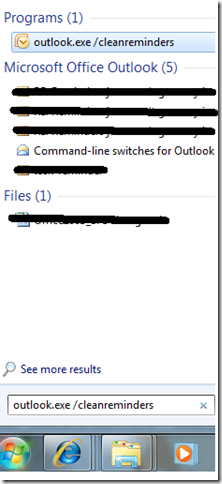/a |
Creates an item with the specified file as an attachment.
Example: "C:\Program Files\Microsoft Office\Office11\Outlook.exe" /a "C:\My Documents\labels.doc" Note: If no item type is specified, IPM.Note is assumed. Cannot be used with message classes that aren't based on Outlook. |
/altvba otmfilename |
Opens the VBA program specified in otmfilename, rather than %appdata%\Microsoft\Outlook\VbaProject.OTM. |
/c messageclass |
Creates a new item of the specified message class (Outlook forms or any other valid MAPI form). Some of the related examples:
- /c ipm.activity creates a Journal entry
- /c ipm.appointment creates an appointment
- /c ipm.contact creates a contact
- /c ipm.note creates an e-mail message
- /c ipm.stickynote creates a note
- /c ipm.task creates a task
|
/checkclient |
Prompts for the default manager of e-mail, news, and contacts. |
/cleanclientrules |
Starts Outlook and deletes client-based rules. |
/cleandmrecords |
Deletes the logging records saved when a manager or a delegate declines a meeting. |
/cleanfinders |
Removes Search Folders from the Microsoft Exchange server store. |
/cleanfreebusy |
Clears and regenerates free/busy information. This switch can only be used when you are able to connect to your Microsoft Exchange server. |
/cleanprofile |
Removes invalid profile keys and recreates default registry keys where applicable. |
/cleanpst |
Launches Outlook with a clean Personal Folders file (.pst). |
/cleanreminders |
Clears and regenerates reminders. |
/cleanrules |
Starts Outlook and deletes client- and server-based rules. |
/cleanschedplus |
Deletes all Schedule+ data (free/busy, permissions, and .cal file) from the server and enables the free/busy information from the Outlook Calendar to be used and viewed by all Schedule+ 1.0 users. |
/cleanserverrules |
Starts Outlook and deletes server-based rules. |
/cleansniff |
Deletes duplicate reminder messages. |
/cleansubscriptions |
Deletes the subscription messages and properties for subscription features. |
/cleanviews |
Restores default views. All custom views you created are lost. |
/designer |
Starts Outlook without figuring out if Outlook should be the default client in the first run. |
/embedding |
Opens the specified message file (.msg) as an OLE embedding. Also used without command-line parameters for standard OLE co-create. |
/f msgfilename |
Opens the specified message file (.msg) or Microsoft Office saved search (.oss). |
/firstrun |
Starts Outlook as if it were run for the first time. |
/hol holfilename |
Opens the specified .hol file. |
/ical icsfilename |
Opens the specified .ics file. |
/importprf prffilename |
Launches Outlook and opens/imports the defined MAPI profile (*.prf). If Outlook is already open, queues the profile to be imported on the next clean launch. |
/l olkfilename |
Opens the specified .olk file. |
/launchtraininghelp assetid |
Opens a Help window with the Help topic specified in assetid. |
/m emailname |
Provides a way for the user to add an e-mail name to the item. Only works in conjunction with the /c command-line parameter.
Example: Outlook.exe /c ipm.note /m emailname |
/nocustomize |
Starts Outlook without loading outcmd.dat (customized toolbars) and *.fav file. |
/noextensions |
Starts Outlook with extensions turned off, but listed in the Add-In Manager. |
/nopollmail |
Starts Outlook without checking mail at startup. |
/nopreview |
Starts Outlook with the Reading Pane off. |
/p msgfilename |
Prints the specified message (.msg). Does not work with HTML. |
/profile profilename |
Loads the specified profile. If your profile name contains a space, enclose the profile name in quotation marks ("). |
/profiles |
Opens the Choose Profile dialog box regardless of the Options setting on the Tools menu. |
/recycle |
Starts Outlook using an existing Outlook window, if one exists. Used in combination with /explorer or /folder. |
/resetfoldernames |
Resets default folder names (such as Inbox or Sent Items) to default names in the current Office user interface language.
Note: If you first connect to your mailbox Outlook using a Russian user interface, the Russian default folder names cannot be renamed. To change the default folder names to another language such as Japanese or English, you can use this switch to reset the default folder names after changing the user interface language or installing a different language version of Outlook. |
/resetfolders |
Restores missing folders for the default delivery location. |
/resetnavpane |
Clears and regenerates the Navigation Pane for the current profile. |
/rpcdiag |
Opens Outlook and displays the remote procedure call (RPC) connection status dialog. |
/s filename |
Loads the specified shortcuts file (.fav). |
/safe |
Starts Outlook without extensions, Reading Pane, or toolbar customization. |
/safe:1 |
Starts Outlook with the Reading Pane off. |
/safe:2 |
Starts Outlook without checking mail at startup. |
/safe:3 |
Starts Outlook with extensions turned off, but listed in the Add-In Manager. |
/safe:4 |
Starts Outlook without loading Outcmd.dat (customized toolbars) and *.fav file. |
/select foldername |
Starts Outlook and opens the specified folder in a new window. For example, to open Outlook and display the default calendar use: "c:\Program Files\Microsoft Office\Office11\Outlook.exe" /select outlook:calendar |
/sniff |
Starts Outlook and forces a detection of new meeting requests in the Inbox, and then adds them to the calendar. |
/t oftfilename |
Opens the specified .oft file. |
/v vcffilename |
Opens the specified .vcf file. |
/vcal vcsfilename |
Opens the specified .vcs file. |
/x xnkfilename |
Opens the specified .xnk file. |
